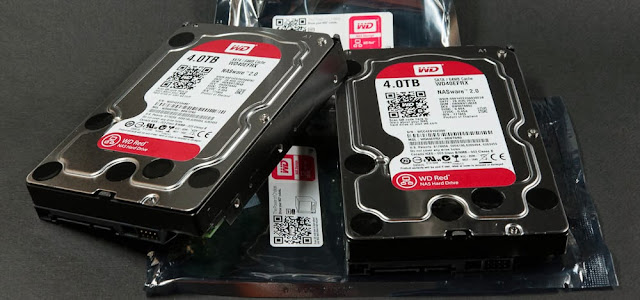The disk industry has undergone an incredible consolidation: there are only three companies left. Toshiba is focused on laptop disks, while Seagate and Western Digital manufacture the whole range. In this battle to the last tooth, the color of disks has become an important survival tool.
Of course there are many more brands than the three manufacturers. The reason is that there is a number of operating systems (Windows, Mac OS, Linux, etc.) each of which can use a number of file systems (ZFS, NTFS, HFS+, FAT, ext4, ext3, etc.) that can be accessed over a number of network protocols (SMB, NFS, CIFS, AFS, etc.) or over a number of local buses (USB, Thunderbolt, SCSI, SATA, Fibre Channel, FireWire, etc.).
In this fierce competition where you get high performance and high quality at a low price, the disk architect will make trade-offs on what to implement in the firmware and how. When computer makers buy large quantities of disks, the branded makers can write their own firmware that is optimized for the operating system, file system, bus, etc. combination in their specific computer. This is why they can charge an arm and a leg for their branded disks: you get more and pay a lot more.
In addition to the firmware, the disk architect can tweak parameters like rotational speed, cache size, number of platters, vibration robustness, on/off cycles, power consumption, encryption, error correction, etc.
The result of this is that the two manufacturers have a relatively large number of disks in their catalogs, which have become hard to navigate. When you are on the market for a drive, it has become hard to find the best match for your needs.
Western Digital is color coding their drives to help you find the optimal drive.
Blue is used for everyday computing, runs at 7200 rpm in a PC powered on all day.
Black is the high performance (dual processor, dynamic cache) version with high capacity, running at 7200 rpm.
Green is for cool low power running at 5400 rpm for use as a secondary drive. It it is also suited for MAID (massive array of idle drives) used for cold storage, where only 25% of the disks are typically spinning and latency is not an issue.
Red is optimized for 24x7 operation in NAS, running at 5400 rpm with high vibration tolerance, low power consumption, error recovery control, better error correction, and support of the ATA Streaming Command Set.
If you are looking for a drive, blue can give you the blues — you are better off with solid state storage (SSD) for your boot disk. Unless you are a black belt and intensively use a lot of data, in which case black is your color.
If you have a lot of data you only rarely access, it is better to use a secondary disk for that data. Here green is your best color.
The best solution in SOHO or consumer applications is to have small SSDs in your PC and then have a NAS with red disks in a RAID 1 configuration (mirroring without parity or striping). You also want to keep a second NAS in a remote location for disaster recovery, and you keep it updated via uni-directional asynchronous replication (trickle charging).
More in the next post…





No comments:
Post a Comment